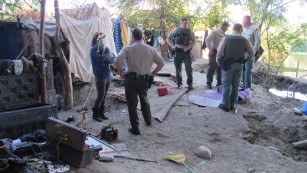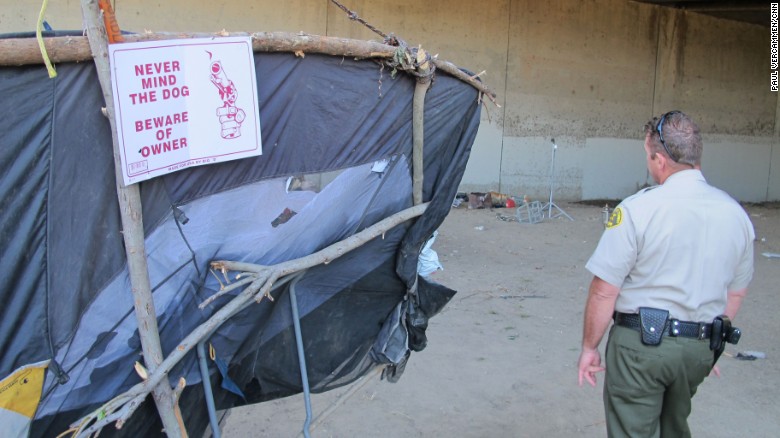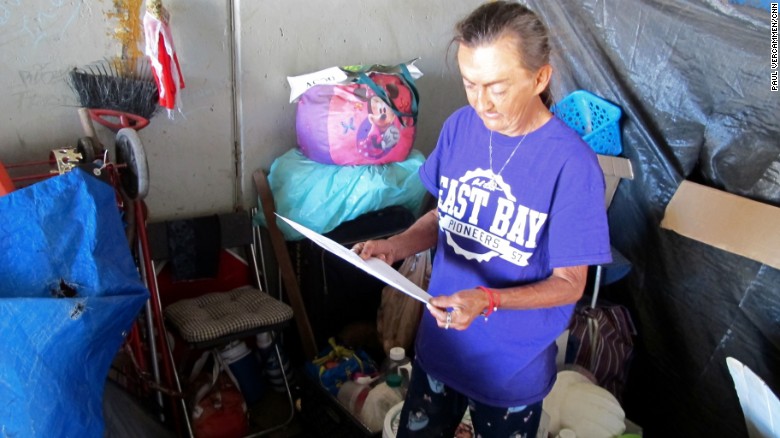Warning river dwellers of the coming storm
especiales

Cars and trucks rumble overhead as the couple listens to their visitor's dire warning.
"When the rains come, it's going to be pretty bad," Geff Deedrick tells them. Deedrick is a lieutenant in the Los Angeles Sheriff's Department. "We don't want anybody to get killed in the flood."
This winter threatens to put two of California's biggest issues on a collision course.
One is natural: After years of drought, a record El Niño is predicted to bring heavy rains to the state.
The other is man-made: After years of skyrocketing housing costs, a record number of homeless people dwell on the streets -- and in the cement culverts and dry riverbeds that crisscross the region.

When it rains in California, roiling torrents race downhill from mountain slopes and valley streets to the Pacific, turning the dry beds and culverts into raging rivers.
CNN recently accompanied Deedrick and a handful of other officers as they took their warning to the underpasses and riverbeds, talking to homeless people and handing out fliers.
It was a journey into a hidden world of misfortune that millions of Californians drive over each day, unaware of its existence.
The exact number of homeless river dwellers is difficult to pin down. But a rough estimate from conversations with law enforcement and social workers in nine Southern California counties puts the number at about 2,000. That includes as many as 800 in Los Angeles County and another 300 in Ventura County.
Homelessness here has grown substantially since the last El Niño, which dumped 30 inches of rain on Los Angeles during the winter of 1997-98, authorities say. In September, the Los Angeles City Council declared a state of emergency on homelessness and called for $100 million to help address the growing crisis.
"This huge homeless population is already so vulnerable, and life becomes even more difficult with the El Niño conditions," said Naomi Goldman, spokeswoman for the Los Angeles Homeless Services Authority.
El Niño is a cyclical rise in surface temperatures in the equatorial Pacific Ocean that influences jet stream patterns and rainfall totals and can cause unusual weather around the world.
Based on current sea surface temperatures, there's a 95% chance El Niño will bring repeated storms to California this winter, says National Weather Service meteorologist Mark Jackson.
"And that means above-average rainfall," he said. Perhaps even record rainfall.
To make sure the riverbed homeless get the message, officers have been taking to the culverts in all-terrain vehicles. But will their warnings be heeded?
The homeless couple Deedrick spoke to under the 60 Freeway didn't start packing. Their spot on the cement along the San Gabriel River features a barbecue and a television powered by a single solar panel.
"Are you willing to go to a shelter?" Deedrick asked.
"No," the man grunted.
"Why not?"
"Because the shelters have rules, and you have to be in at certain times," the man said. "You can't do this. You can't do that."
The officers kept pressing the couple to pack up and leave but stopped short of putting them in handcuffs.
"Our goal is to get them help, transition out of homelessness, it's not to arrest them for now," Deedrick said. "We have time."
El Niño usually peaks from January through March, the National Weather Service says.
Should a potentially lethal storm from El Niño threaten Southern California, Deedrick said the officers would use other means if necessary, including charging homeless people with trespassing and illegal camping.















Add new comment